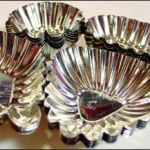By Cat, Jun 2008 (Photo, right, from Wikimedia Commons)
- See also: 1. Cookies Menu; 2. Scandinavian Foods Menu
- Includes: 1. Sandbakkel tins; 2. About ingredients; 3. Recipe;
Sand cookies are a great Scandinavian treat; I’m not sure why they are called ‘Sand‘. There are two main types of Sand cookies:
- Sandbakels (Norsk) or sandbakkelser (Dansk, Swedish): For these, the dough is pressed into a tiny fluted mold that resembles a miniature tart pan. They are typically served as is (upside down so you can better see the pattern), but they may also be filled with preserves or nuts with whipped cream.
- Sand kager (Norsk, Swedish) or sandkager (Dansk): These are most like Scottish shortbread and can be made by pressing out to cover an entire cookie sheet, then cut into squares after baking, or rolled into balls and flattened with a sandbagger press. NOTE: Sandies is an Anglicized name for this cookie. Cornmeal sandies are not Scandinavian, but are a similar cookie.
It has been a long, long time since I’ve made sandbakkels – long before I started this recipe blog. They are time-consuming, pressing the dough into the tins, and then carefully removing them after baking. But they are so worth the effort once a year.
Sandbakkel tins
Photo, left, from Ingebretsens, but that photo is no longer available on their site.
Sandbakkel tins are like tiny tart pans, and come in various sizes & shapes, including squares, diamonds, triangles and ovals. I bought mine through our local Son’s of Norway, but you may be able to find them online.
About ingredients for Sandbakkelser
Sugar is an essential ingredient for the proper texture of these cookies, so I have not attempted to replace with stevia. Minimally processed Rapadura sugar (dried sugar cane juice) will work wonderfully in these recipes, and is more healthful; however, it adds a caramel color that may not be desirable for holiday celebrations.
Flour: Most modern recipes call for all white flour, but I prefer to use a bit of whole wheat pastry flour to improve the nutritional quality of the cookie. Or, for a lighter color, hard white winter wheat, such as Wheat Montana’s Prairie Gold could be used. Nutritionally, spelt is a better flour, but I don’t like it for these cookies.
Butter: Always use unsalted butter for these cookies, for the best result. Do not use margarine or ‘vegetable spread’ for these cookies, as they will lose their shape in the oven. Also, don’t use vegetable shortening as it contains toxic trans-fats.
Flavoring: Many sand cookies include almond flavoring – either as an extract, or as ground almonds. This recipe uses almond extract.
Sandbakkelser (or Sandbakels)
This recipe is adapted from Wonderful Wonderful Danish Cooking, by Ingeborg Dahl Jensen, and makes about 4 dozen cookies. Generally, I like to substitute part of the white flour with whole wheat pastry flour, but I have not tested this with this recipe. The flour is measured after sifting. Be sure to use unsalted butter for the best result.
These cookies are a bit of work; something you make for a special celebration or a holiday. You can serve them plain (upside down to show off the detail made by the cookie tin), without filling, or right-side up to fill just before serving with:
- whipped cream;
- whipped cream flavored with a bit of cardamom
- whipped cream and preserves; or
- whipped cream and chopped almonds.
I’ve not yet tested this particular recipe.
Ingredients & Equipment:
- Cookie:
- 2 ½ cups unbleached white flour (or part unbleached white flour, part whole wheat pastry flour)
- 1 cup ( 2 sticks) soft butter, unsalted
- 1 cup Rapadura sugar or white cane sugar
- 1 egg
- ½ tsp almond extract
- Filling (optional):
- Heavy raw cream or whipping cream
- Fruit preserve filling (optional)
- Chopped almonds (optional)
- Ground cardamom (optional)
- Equipment:
- flour sifter
- small bowl
- wooden spoon or electric mixer
- sandbakkel tins
- cookie sheet
Method:
- Preheat oven to 3750 F .
- Place flour in sifter; sift into a 1 or 2 cup dry measure. Measure 2 ½ cups of the mixture, adding additional sifted white flour if needed. After each measure, pass a knife blade across the cup so that the top of the flour is exactly even with the measuring cup. Set aside in small bowl.
- Cream butter and sugar together in large bowl until smooth.
- Add egg and extract, and cream again.
- Mix in the sifted flour.
- Pinch off small pieces of dough about the size of a walnut (this will vary with the size of your tins). Press dough thinly and evenly into sides and bottom of the tin. Place tins on cookie sheet
- Bake in preheated oven, about 12 minutes.
- Remove to rack, to cool. When cool, tap gently on bottoms of tins; the cookies should drop out easily. They are very fragile, so remove carefully.
Assembly or Serving ideas
- Serve plain, without filling.
- Fill with whipped cream and optional fruit preserves or nuts just before serving.
- You can flavor the whipped cream with a bit of ground cardamom, if desired.
References:
- Wonderful Wonderful Danish Cooking, by Ingeborg Dahl Jensen (see Beloved Cookbooks for more)
- Ingebretsens (ingebretsens.com)


